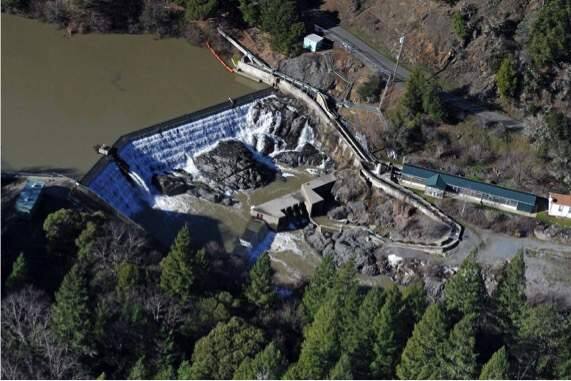
THE EDITORIAL BOARD, February 6, 2022
The clock is winding down on the Potter Valley Project. PG&E wants to abandon the century-old power plant in Mendocino County, and a coalition of North Coast water interests has now abandoned their long-shot takeover bid.
But football games don’t end after three quarters, and the Potter Valley saga isn’t over either.
It’s now a near certainty that the money-losing power plant will be decommissioned and dismantled. But keeping the plant open was only an ancillary consideration, a means to an end. As is so often the case in California, this is really about water.
Water in the Russian River.
Water in the Eel River.
Water in Lake Mendocino.
Water in Lake Pillsbury.
Since 1908, water from the Eel has flowed through a tunnel 8 feet in diameter and dropped 450 feet through penstocks to spin the turbines at the Potter Valley powerhouse. From there, the water flows into the East Fork of the Russian River.
Plumbing for the hydropower project provided a year-round water supply that transformed the upper Russian River basin. But two dams that pool water for the diversion tunnel created an impassable barrier for salmon and steelhead on the Eel.
A battle over the project’s future has been brewing for years, with a showdown anticipated this year when PG&E’s operating license came up for renewal.
Farmers and cities in Mendocino and Sonoma counties rely on water flowing into the Russian, conservationists say restoring the Eel is crucial to endangered fisheries, and property owners at Lake Pillsbury, a Lake County reservoir formed by Scott Dam, also have a stake in the outcome.
PG&E bought the hydroelectric plant in 1930 and offered it for sale in 2018. There were no takers, and the utility announced plans to surrender the license in 2019.
Enter the Two-Basin Solution Partnership, a coalition including Sonoma, Mendocino and Humboldt counties, California Trout and the Round Valley Indian tribes formed to explore acquisition of the license and re-engineering of the infrastructure to keep water flowing into the Russian River during wet winter months while reopening the headwaters of the Eel to migratory fish.
The two-basin plan was never going to satisfy all the stakeholders, but its failure was the product of insurmountable costs and deadlines. The partnership was unable to obtain $18 million needed for preliminary studies, and the Federal Energy Regulatory Commission refused to extend an April 14 deadline to submit a license application. Had they succeeded, they would have acquired a power plant that loses $9 million a year.
With the plant out of the equation, negotiations can focus on the needs of the Eel and Russian river watersheds. The two-basin approach mediated by Rep. Jared Huffman, D-San Rafael, remains the most equitable and viable solution.
PG&E holds the water rights, which could become a bargaining chip as decommissioning plans for the power plant and, presumably, removal of Scott and Cape Horn dams advance. The process could take five years or more, with PG&E continuing to operate the plant on one-year license extensions.
The announcement that the Two-Basin Partnership will not seek the license after all wasn’t the only big development this past week. PG&E will replace a damaged transformer that has necessitated a drastic reduction in water flowing through the Potter Valley plant, PG&E spokesman Paul Moreno confirmed Friday.
The repairs could take a couple of years, which may extend cutbacks for upper Russian River water users. It also provides time to complete a two-basin agreement and ensure that any hardships aren’t permanent. Don’t let the clock run out.
You can send letters to the editor to letters@pressdemocrat.com.

